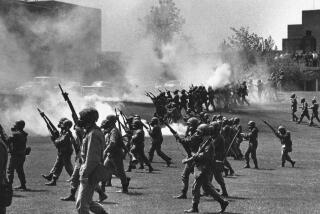Kent State Shooting Shattered a Generation
- Share via
For many Americans--particularly the white and middle class--the news of Kent State hit like a smack of revelation. A shift in American culture can be dated--at least in part--to that Monday afternoon in 1970.
The baby boom generation, pollsters tell us, remains far more cynical, far less trusting of government and of authority in general than either its elders or its children. And no wonder. If officers of the government--National Guard troops--could shoot and kill four unarmed college students on a spring day in Ohio, then who’s to say what else might be possible?
What happened there, and why? Think first about when and where.
The first large-scale demonstration against the war in Vietnam took place in 1965. It was small by later standards--25,000 people marching in Washington. As the number of U.S. troops and casualties in Vietnam increased, so did the size of the demonstrations.
By 1968, the shouts of protest (“Hey, Hey, LBJ, how many kids did you kill today?”) had helped drive President Lyndon B. Johnson from office. Richard M. Nixon won the presidency promising law and order to stop the demonstrations and a secret plan to end the war.
American campuses provided the recruits and the locales that brought the protest movement alive. Berkeley, Columbia, Harvard, Wisconsin became synonymous with sit-ins, strikes, occupations and rallies.
These were elite schools for the children of America’s elite. That status offered a limited amount of protection, but shrewd politicians like Nixon knew it also created a weakness to exploit--elite students were vulnerable to the charge that they did not share the values of America’s “silent majority.”
By 1970, however, the war had dragged on longer than World War II, and even the silent majority had begun losing patience.
Thus it was that on April 30, 1970, when Nixon announced that American forces had gone beyond Vietnam to invade Cambodia, not only elite schools erupted in protest. So did places like Kent State.
Such schools had no ivy-covered traditions to shelter them against authority. On Saturday, May 2, Gov. James Rhodes sent the National Guard to Kent. The troops arrived that night, ill-trained for civil disturbances and armed with World War II-era carbines. The smoke of a burning ROTC barracks soon mingled with tear gas in the campus air.
*
Sunday was largely quiet, but on Monday, May 4, about 3,000 people--many of them spectators--and about 100 guard troops converged at a previously scheduled campus rally. Officials ordered the crowd to disperse. The troops fired tear gas as students responded with rocks. Soon, the troops charged forward, forcing the crowd over a hill and back toward a parking lot. Then, as the guard troops headed back up the hill, one group of 28 turned, lowered its rifles, and fired.
It was 12:25. The soldiers shot 61 to 67 rounds in 13 seconds. Sandra Scheuer was walking across campus to get to a class. She was 390 feet away from the troops--more than the length of a football field--when a bullet pierced her back. Allison Krause had put a flower in a soldier’s gun barrel the day before. She died not far from Scheuer. Jeffrey Miller was 19 and an active protester. William Schroeder was 20 and an ROTC student. Miller took his fatal bullet in the face; Schroeder’s tore through his left lung. Nine other students were injured; one was paralyzed.
John Filo, a photography major standing nearby, took a picture of Mary Vecchio, a 14-year-old runaway, screaming next to Miller’s body. The picture, printed around the world, including on The Times’ front page, became an icon.
From the first, people’s attitudes toward that moment--and their explanations of it--sharply polarized. A guard official initially said the soldiers had fired in response to a sniper. There was no sniper, and guard officials quickly shifted, saying that the troops had fired in self-defense, fearing students would attack them. A large percentage of the nation agreed.
By contrast, a federal commission led by former Pennsylvania Gov. William Scranton concluded that the shootings were “unnecessary, unwarranted and inexcusable.” Other investigators went further. Several books accused the troops of having decided ahead of time to shoot when they reached the top of the hill.
A state grand jury investigated and brought several indictments--against students. Three years later, a federal grand jury indicted eight guardsmen. A judge dismissed the case halfway through trial. A civil suit against the guardsmen and Rhodes ended with a $675,000 settlement and a statement that one side took as an apology, the other as only a statement of regret.
Apology. Regrets. Proposals for memorials to the Kent State dead have been controversial for three decades. America still cannot quite make up its collective mind about Vietnam’s deaths--abroad or at home. The unreconciled ghosts still haunt us.
More to Read
Sign up for Essential California
The most important California stories and recommendations in your inbox every morning.
You may occasionally receive promotional content from the Los Angeles Times.














